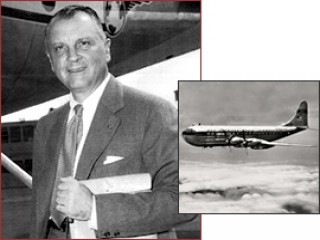
Juan Terry Trippe biography
Date of birth : 1899-06-27
Date of death : 1981-04-03
Birthplace : New York City, New York, U.S.
Nationality : American
Category : Arhitecture and Engineering
Last modified : 2011-08-23
Credited as : Aviation pioneer, airline entrepreneur , Pan American World Airways
Juan Terry Trippe (1899-1981), the undisputed pioneer of the American overseas aviation industry, led Pan American Airways from 1927 to 1968. Having opened up Latin America, the African periphery, the Pacific, and Southeast Asia during the 1930s, Pan American played an important role in World War II before spearheading mass, low-cost tourism across the North Atlantic to Western Europe in the 1950s.
Juan Trippe was born on June 27, 1899, to a well-off New York family, which, despite his first name, had no significant Hispanic connections. He attended the Hill School and entered Yale University in 1917. Trippe and some classmates became Navy pilots after America entered World War I, but they saw no combat. He later returned to Yale, graduated in 1921, and became a Wall Street bond salesman.
But Trippe and his wealthy associates were fascinated by aviation, whose future seemed rich with possibilities. Having bought some surplus Navy planes in 1923, they organized Long Island Airways before creating Colonial Air Transport in 1924 to fly between New York and Boston. Aviation attracted little business, however, until the federal government intervened to control entries, routes, and franchises, while also providing airmail contracts as virtual subsidies. After a dispute within Colonial over extending it to Miami, Trippe resigned in 1926 and formed a new corporation, which merged in 1927 with Pan American Airways. He became president and general manager.
Beginning with a 90-mile airmail route from Key West to Havana, Trippe spearheaded Pan American's spectacular expansion into the coastal cities of Latin America and established 11, 000 miles of routes by late 1929. He secured the indispensable U.S. airmail contracts and began lobbying for Pan American's position as a "chosen instrument" of American policy in South America, a continent of vast distances, impenetrable terrain, and many U.S. strategic and economic interests. State Department backing often bolstered his negotiations with foreign governments for routes, landing rights, terminals, and customs' privileges.
In 1929 W. R. Grace & Co. and Pan American organized Panagra (Pan American and Grace Airways) to operate on the west coast of Latin America. By the early 1930s Pan American had largely overshadowed its competitors in the region. In return for its government-sponsored quasi-monopoly abroad, Pan American followed Washington's tight regulatory policies by shunning the American market.
Pan American expanded rapidly despite the Great Depression and gained prestige by employing Charles Lindbergh, the "Lone Eagle" of public acclaim, and by turning what had been the adventure of flight into a safe, reliable, and profitable business venture. Trippe built an elaborate infrastructure of weather stations and communications, navigation, and maintenance facilities, first in Latin America and then on Hawaii and other Pacific islands. The Pan American market for long-range aircraft stimulated the American aviation industry, most notably in developing the comfortable, 60-passenger "Clipper, " with which Pan American pioneered service in the mid-1930s both across the Atlantic and via the Pacific to Manila.
Inevitably, Pan American became deeply involved in American foreign policy as World War II approached. There was constant competition over new markets with government-controlled foreign airlines, which contended that Trippe was building a global empire to strengthen American diplomatic and military power. Japan, for example, was angered, first when Trippe bought the China National Aviation Corporation in 1933, and again when he established links to British South Pacific territories after 1939. Simultaneously, the New York-Lisbon Clipper flights became famous, and very lucrative, as one of the few neutral routes into a Europe at war.
Pan American, now linked to the Air Force's global Air Transport Command, became a major contract carrier for the government after Pearl Harbor, particularly in ferrying planes from northeastern Brazil across Africa to the Middle East. Pan American even inaugurated air travel for a president, carrying Franklin D. Roosevelt to and from the Casablanca conference in early 1943. With its German and Italian rivals destroyed, and British and French international airlines greatly weakened financially, Pan American emerged victorious after 1945. But its international monopoly had ended as its American competitors learned the skills of oceanic flight when drafted by Washington into the war effort.
Trippe tried to revivify the "chosen instrument" concept by making Pan American (renamed Pan American World Airways in 1949) into a regulated monopoly, with the federal government owning 49 percent of the stock, but the plan died. In 1950, just as foreign air competitors were reaching American shores, he was refused the right to fly domestically, with the reliable income that this would generate. In 1952 Trippe encouraged mass tourism across the North Atlantic to Western Europe by instituting tourist class fares, with installment purchases after 1954. Volume flights required larger aircraft, and Trippe, having developed commercial jet service in the late 1950s, bought the first Boeing 747s in 1966.
But Trippe's desire to create a vast global system, servicing virtually every airport everywhere without strong regard for volume or profit, combined with a growing foreign and American competition to which Pan American could not adjust. There were major difficulties in the 1960s, with half-filled aircraft and shrinking revenues. Trippe retired in 1968, after 41 years at the helm, and died on April 3, 1981. His empire went downhill. A proposal that the shah of Iran buy it in 1975 was rejected. It filed for bankruptcy early in 1991 and ceased flying later in the year.
















